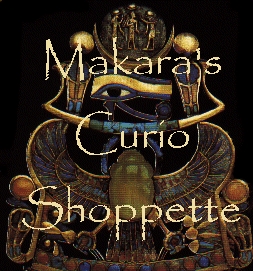

 Taweret
"The Great One." Egyptian hippopotamus goddess and protective deity of childbirth, also protectress of rebirth into the afterlife. She was depicted with the head of a hippopotamus, the legs and arms of a lion, the tail of a crocodile, human breasts, and a swollen belly. Taweret was the most popular among ordinary Egyptians as a protectress. Pregnant women commonly wore amulets bearing the goddess' image. |
 Khnum (Khnemu) "To Create." Egyptian ram god. Khnum was credited with creating life on a potter's wheel at the behest of the other gods. He was also said to control the annual inundation of the Nile, although the god Hapi physically generates the inundation. The goddesses Satis and Anuket assisted him in their supervisory role. His major cult center was on the Elephantine Island near the first cataract of the Nile (Near modern Aswan) where mummified rams sacred to Khnum have been found. He also had an important cult center at Esna, to the north of the first cataract. He was usually depicted inhuman form with a ram's head - the horns extending horizontally on either side of the head - often before a potter's wheel on which a naked human was being fashioned. |
 Sekhmet (Sachmet, Sakhmet) "The Powerful One." Egyptian lioness goddess, daughter of Ra. In Memphis she formed part of the Memphite triad together with Ptah as her consort and Nefertum (otherwise the son of Bastet) as her son. Depicted as a lioness or in a human form with the head of a lioness. She was generally shown crowned by the solar disk, holding the Ankh (life) symbol or a scepter in the shape of a papyrus reed. She was believed to be the bearer of plague and pestilence, but in a more benign aspect she was called upon in spells and amulets to ward of disease. |
 Mut Egyptian vulture goddess and chief goddess of Thebes. Also a mother goddess occasionally referenced to as the queen of all gods. She was depicted in the form of a vulture or in a human form with a vulture headdress and the combined crowns of Upper and Lower Egypt. She was usually dressed in a bright red or blue gown. In Thebes she replaced Amaunet as the consort of the sun god Amun. With their adoptive son Khonsu, the two formed the Theban triad. Her principal sanctuary was in Thebes. |
 Mut |
 Sekhmet |
 Sobek (Greek Suchos) Egyptian crocodile god and son of Neith. Sobek symbolized the might of the Egyptian Pharaohs. At Ra's command, He performed tasks such as catching with a net the four sons of Horus as they emerged from the waters in a lotus bloom. Sobek was admired and feared for his ferocity. Depicted as a crocodile or in human form with the head of a crocodile, crowned either by a pair of plumes or sometimes by a combination of the solar disk and the uraeus. His cult was widespread. Faiyum was particularly noted as a center of his worship and at least one town came to be "Crocodilopolis" by the Greeks. Gebelein, Kom Ombo and Thebes in Upper Egypt were other centers of his cult. |




